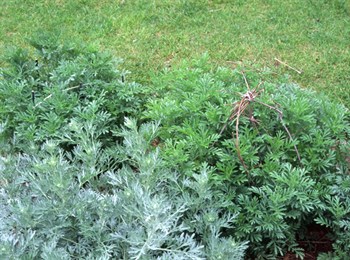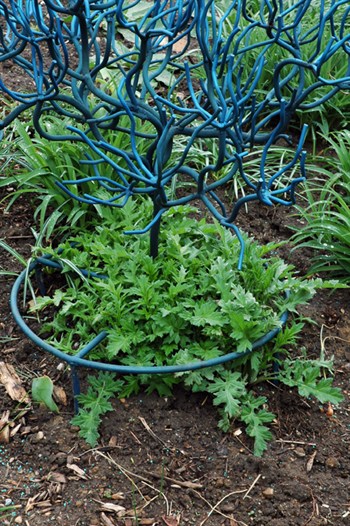...and other thrifty and cool means of support.
Holding up floppy plants with twisted
twigs, hoops, fencing, grow-thru grids, woven branches and sculpture. Soon grown over but why not make them fun
to see until then? Even a bush clematis can
benefit from such support.
If:
Then you're cutting shrubs back hard in late winter and early
spring. Many of those canes are great for staking perennials. Keep
those that have no thorns, are at least 24" long and have some
branches toward the tip. They make great pre-emptive crutches for
floppy plants.
Twisted
twigs
Here are burning bush branches (below, left) and rose of sharon branches (below, right) placed
to stake a peony (arrows mark some of the peony shoots.) The
burning bush branches have plenty of crotches which will serve as
crutches. The rose of Sharon branches were not so twiggy, so I
braided them like wattle.


And here are some other staking tools. Whatever you do in terms
of staking, do it early so you won't have to spend time trying to
pick up plants and make them presentable after they tumble in
summer.
Grow-thru grids
Below, left: We like the grow-thru grids best of the staking
kits we can buy. They're quick to place, and unseen once the plant
grows through.
Below, right: Arrow points out the nearly-covered
ring.


Hoops and
fencing
Below: Hoops and fencing as perimeter supports. We call them
police lines -- one can lean on them and even reach over them but
not cross them.
If you stake with hoops, there won't be anything to keep the
inner stems from leaning out. And if you stake with fencing, keep
in mind that it's going to be tough to reach into that cage to weed
around the base of the caged plant.


We prefer gridded supports or staking with twigs twisted
together.
Woven branches
How about this work of art? We see this done well in many
European and Canadian gardens, not so often in our own neck of the
woods. This one was in a perennial border at Edinburgh Royal
Botanical Garden, Scotland.

Soon grown
over!
When you stake in April and May, the staking arrangement may be
noticeable for a few weeks but the plants soon cover it.
Below: These photos were taken three weeks apart, in
May.


A
staking sculpture, our invention
Here's a staking sculpture we designed and had made by a local
artist. We love it. It's a perma-stake! Take the photos to someone
like Brian Kennedy at Bad Axe Iron Works and have him
make one like it for you.





We support peonies and blue
globe thistle with the supports we have of this type, but could use
them for any other plant in a place that deserves winter attention.
This blue bush clematis (Clematis heracleifolia), for
instance. (More about this particular
clematis on the Forum.)
